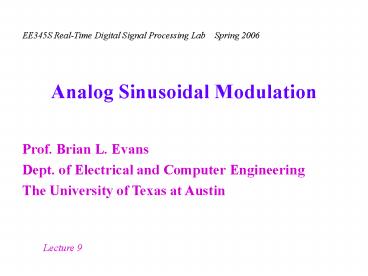Analog Sinusoidal Modulation - PowerPoint PPT Presentation
Title:
Analog Sinusoidal Modulation
Description:
Analog Sinusoidal Modulation Single-Carrier Modulation Methods Analog communication Transmit/receive analog waveforms Amplitude Modulation (AM) Freq. Modulation (FM ... – PowerPoint PPT presentation
Number of Views:118
Avg rating:3.0/5.0
Title: Analog Sinusoidal Modulation
1
Analog Sinusoidal Modulation
2
Single-Carrier Modulation Methods
- Analog communication
- Transmit/receive analog waveforms
- Amplitude Modulation (AM)
- Freq. Modulation (FM)
- Phase Modulation (PM)
- Quadrature Amplitude Mod.
- Pulse Amplitude Modulation
- Digital communication
- Same but treat transmission and reception as
digitized - Amplitude Shift Keying (ASK)
- Freq. Shift Keying (FSK)
- Phase Shift Keying (PSK)
- QAM
- PAM
3
Radio Frequency (RF) Modem
- Message signal stream of bits
- Digital sinusoidal modulation in digital
signaling - Analog sinusoidal modulation in carrier circuits
for upconversion to RF
Error Correction
Digital Signaling
D/A Converter
SignalProcessing
CarrierCircuits
Transmission Medium
Carrier Circuits
SignalProcessing
s(t)
r(t)
TRANSMITTER
RECEIVER
CHANNEL
4
Modulation
- Modulation some characteristic of a carrier
signal is varied in accordance with a modulating
signal - For amplitude, frequency, and phase modulation,
modulated signals can be expressed as - A(t) is real-valued amplitude function
- fc is carrier frequency
- ?(t) is real-valued phase function
5
Amplitude Modulation by Cosine
Review
- Multiplication in time convolution in Fourier
domain (let w0 2 p f0) - Sifting property of Dirac delta functional
- Fourier transform property for modulation by a
cosine
6
Amplitude Modulation by Cosine
Review
- Example y(t) f(t) cos(w0 t)
- Assume f(t) is an ideal lowpass signal with
bandwidth w1 - Assume w1 ltlt w0
- Y(w) is real-valued if F(w) is real-valued
- Demodulation modulation then lowpass filtering
- Similar derivation for modulation with sin(w0 t)
7
Amplitude Modulation by Sine
Review
- Multiplication in time is convolution in Fourier
domain - Sifting property of the Dirac delta functional
- Fourier transform property for modulation by a
sine
8
Amplitude Modulation by Sine
Review
- Example y(t) f(t) sin(w0 t)
- Assume f(t) is an ideal lowpass signal with
bandwidth w1 - Assume w1 ltlt w0
- Y(w) is imaginary-valued if F(w) is real-valued
- Demodulation modulation then lowpass filtering
lower sidebands
9
Amplitude Modulated (AM) Radio
- Double sideband large carrier (DSC-LC)
- Carrier wave varied about mean value linearly
with baseband message signal m(t) - ka is the amplitude sensitivity, ka gt 0
- Modulation factor is ? ka Am where Am is
maximum amplitude of m(t) - Envelope of s(t) has about same shape as m(t) if
- ka m(t) lt 1 for all t
- fc gtgt W where W is bandwidth of m(t)
10
Amplitude Modulation
- Disadvantages
- Redundant bandwidth is used
- Carrier consumes most of the transmitted power
- Advantage
- Simple detectors (e.g. AM radio receivers for
cars) - Receiver uses a simpleenvelope detector
- Diode (with forwardresistance Rf ) in series
- Parallel connection ofcapacitor C and
loadresistor Rl
11
Amplitude Modulation (cont)
- Let Rs be source resistance
- Charging time constant (Rf Rs) C must be short
when compared to 1/ fc, so (Rf Rs) C ltlt 1/ fc - Discharging time constant Rl C
- Long enough so that capacitor discharges slowly
through load resistor Rl between positive peaks
of carrier wave - Not so long that capacitor voltage will not
discharge at max rate of change of modulating
wave 1/fc ltlt Rl C ltlt 1/W
12
Other Amplitude Modulation Types
- Double sideband suppressed carrier (DSB-SC)
- Double sideband variable carrier (DSB-VC)
- Single sideband (SSB) Remove either lower
sideband or upper sideband by - Extremely sharp bandpass or highpass filter, or
- Phase shifters using a Hilbert transformer
13
Quadrature Amplitude Modulation
- Allows DSB-SC signals to occupy same channel
bandwidth provided that the two message signals
are from independent sources - Two message signals m1(t) and m2(t) are sent
- Ac m1(t) is in-phase component of s(t)
- Ac m2(t) is quadrature component of s(t)
14
Frequency Modulated (FM) Radio
- Message signal analog audio signal
- Transmitter
- Signal processing lowpass filter to reject above
15 kHz - Carrier circuits sinusoidal modulatation from
baseband to FM station frequency (often in two
modulation steps) - Receiver
- Carrier circuits sinusoidal demodulation from FM
station frequency to baseband (often in two
demodulation steps) - Signal processing lowpass filter to reject above
15 kHz
15
Frequency Modulation
- Non-linear, time-varying, has memory, non-causal
- For single tone message m(t) Am cos(2 p fm t)
- Modulation index is ? ?f / fm
- ? ltlt 1 gt Narrowband FM (looks like
double-sideband AM) - ? gtgt 1 gt Broadband FM
Instantaneous frequency
16
Carson's Rule
- Bandwidth of FM for single-tone message at fm
- Narrowband
- Wideband
- Carsons rule for single-tone FM
- For a general message signal, fm W
FM Radio TV Audio
?f fm ? Peak freq. deviation (?F) Peak message freq. (W) Deviation ratio (D) Bandwidth BT 2 fm (1? ) Station Spacing 75 kHz 15 kHz 5 180 kHz 200 kHz 25 kHz 15 kHz 1.66 80 kHz 6 MHz
17
Summary
- General form of modulation
Modulation A(t) ?(t) Carrier Type Use
DSB-LC DSB-SC DSB-VC SSB ?0 ?0 ?0 Yes No Yes No Amp. Amp. Amp. Amp. AM Radio Marine Radios
QAM No Hybrid Satellite comm.
Phase Frequency AcAc No No Angle Angle FM Radio
h(t) is the impulse response of a bandpass filter
or phase shifter toeffect a cancellation of one
pair of redundant sidebands.
18
Angle Modulation
Optional
- Angle modulation general form
- Ac is constant carrier amplitude
- ?i(t) is instantaneous angle of modulation in
radians - Average frequency inrad/s over interval Dt
- Instantaneousfrequency in rad/s
- Instantaneous angle
- Phase modulation
- Frequency modulation

